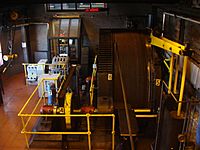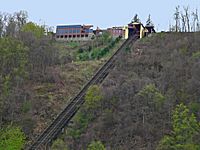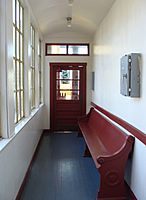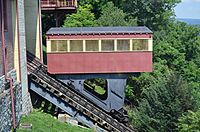Johnstown Inclined Plane facts for kids
Quick facts for kids Johnstown Inclined Plane |
|
|---|---|
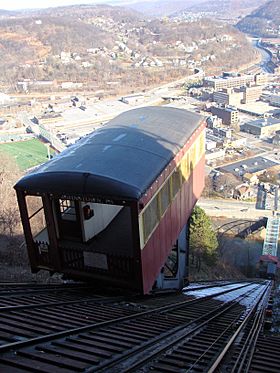 |
|
| Info | |
| Locale | Johnstown, Pennsylvania United States |
| Transit type | Funicular |
| Website | |
| Official name: Johnstown Inclined Railway | |
| Designated: | June 18, 1973 |
| Reference #: | 73001597 |
| Architect: | Samuel Diescher |
|
Historic Mechanical Engineering Landmark
|
|
| Official name: Johnstown Incline | |
| Designated: | September 1994 |
| Reference #: | 180 |
| Operation | |
| Began operation | June 1, 1891 |
| Operator(s) | CamTran |
| Technical | |
| System length | 896.5 ft (273.3 m) |
| Track gauge | 8 ft (2,440 mm) |
The Johnstown Inclined Plane is a special kind of railway in Johnstown, Pennsylvania. It's called a funicular, which means it uses cables to pull cars up and down a very steep hill. This amazing incline is about 896.5 feet (273.2 meters) long.
It connects the city of Johnstown, which is in a valley where two rivers meet, to the town of Westmont on top of Yoder Hill. People say it's the steepest railway in the world that can carry cars! It can move cars and people up or down a very steep slope. The trip between the two stations takes only 90 seconds.
After a terrible flood in 1889, the Johnstown Inclined Plane was built in 1891. Its main purpose was to be a safe escape route during floods. It also made it easy for people to travel between the valley and the new communities on the hill. The incline was used by big steel companies for many years.
It was sold to the town of Westmont in 1935. The incline has helped people escape floods twice: once in 1936 and again in 1977. It is now a recognized historic landmark. It had big updates in 1962 and again from 1983 to 1984.
Contents
How the Johnstown Incline Works
The Johnstown Inclined Plane was designed by a smart engineer named Samuel Diescher. He also designed other similar railways in Pittsburgh. This funicular has two parallel railroad tracks. They are very wide, about 8 feet (2.4 meters) apart. The tracks go up at a very steep angle, about 35 degrees.
The incline is 896.5 feet (273.2 meters) long. It climbs 502.2 feet (153.1 meters) vertically to the top of Yoder Hill. The station at the top is 1,693.5 feet (516.2 meters) above sea level. The tracks are held up by 720 strong wooden supports. These supports are about 14 feet (4.3 meters) long.
At night, 114 bright lights shine along the tracks. There used to be a stairway with 966 steps between the tracks, but it was removed around 1963.
The Cars and Cables
Two cars move on the slope. As one car goes down, the other car goes up. This helps balance the weight. The cars are 15.5 feet (4.7 meters) wide and 15.2 feet (4.6 meters) tall. They are also 34 feet (10 meters) long.
Each car is big enough to carry 65 people, 6 motorcycles, or even a car! The cars are open, but there is a covered seating area inside with a bench.
Strong steel cables connect the cars. These cables are 2 inches (5.1 cm) thick. They wrap around a huge drum that weighs 3 tons (2.7 metric tons). This drum is 16 feet (4.9 meters) wide. A powerful 400-horsepower electric motor makes the drum turn. This pulls one cable up while letting the other cable down.
The Johnstown Inclined Plane is special because its motor is placed at a 90-degree angle to the incline. Most other inclines have the motor directly underneath. A person in the upper station controls the incline using a foot pedal.
Safety Features
The incline has an emergency brake. This brake turns on if there isn't enough air pressure to control the incline. It also engages if the operator lets go of a special "dead man's switch."
Besides the main cables, there is also a safety cable. This safety cable is 972 feet (296 meters) long. It is strong enough to hold 165 tons (150 metric tons). This makes sure the cars are always safe.
History of the Incline
Building a Lifeline
Inclined railways were common in Europe. Many immigrants who came to Johnstown remembered them from their home countries. The idea came to the United States. The first inclines in the U.S. were built in the 1830s. They were part of a railroad that carried canal boats over mountains.
On May 31, 1889, a dam broke upstream from Johnstown. The huge flood that followed destroyed the city. It killed 2,209 people. As the city was being rebuilt, a company called Cambria Iron Company started building homes on Yoder Hill.
To make it easy for people to get to these new homes in Westmont, the company built the inclined plane. It was not just a convenient way to travel. It was also a way to escape if another flood happened. The rails for the incline were made right there in Johnstown.
The incline also needed a bridge to cross the Stonycreek River. This bridge was 232 feet (71 meters) long. The Johnstown Inclined Plane opened on June 1, 1891. It cost about $133,296 to build. Because of the incline, Westmont grew very quickly. It became one of the country's first suburbs. In its first 80 years, over 40 million trips were taken on the incline!
Changes and Challenges
The incline first used a steam engine. But on January 6, 1912, it was changed to an electric motor. The cars were originally two stories tall. They carried horses and wagons on the top deck and people below. In 1921, they were changed to a single-deck design.
Only one person has ever died at the incline. It was found that the incline itself did not cause the accident. In the 1920s, two horses got scared while on the incline and jumped off the car.
In April 1935, the incline was sold to the town of Westmont. On March 17, 1936, almost 4,000 people used the incline to escape Johnstown. The rivers were overflowing, and the city was flooding again.
In 1962, the incline had to close briefly. The steel factory that supplied its electricity changed its power system. But people wanted the incline to keep running. So, it reopened in July 1962 after big repairs. The motor was fixed, and the cars were repainted.
The Johnstown Inclined Plane was listed as a historic place in 1973. On July 20, 1977, it was used again to help people escape a flood. It also carried rescue workers and equipment down to the valley.
In 1983, the incline was sold to the local transit company, CamTran. CamTran spent $4.2 million to renovate it. They replaced the foundation, steel, and tracks. The work finished in 1984. In 1994, it was named a Historic Mechanical Engineering Landmark.
The incline has had other closures for repairs over the years. In 2010, a thunderstorm caused a power outage. Two passengers were stuck halfway down the slope. Firefighters had to rappel down to rescue them.
The Incline Today
| Historical ridership | ||
|---|---|---|
| Year | Pass. | ±% |
| 1996 | 142,109 | — |
| 1997 | 120,156 | −15.4% |
| 1998 | 118,802 | −1.1% |
| 1999 | 120,456 | +1.4% |
| 2000 | 121,779 | +1.1% |
| 2001 | 66,620 | −45.3% |
| 2002 | 74,485 | +11.8% |
| 2003 | 72,431 | −2.8% |
| 2004 | 65,685 | −9.3% |
| 2005 | 86,031 | +31.0% |
| 2006 | 109,222 | +27.0% |
| 2007 | 104,238 | −4.6% |
| 2008 | 100,653 | −3.4% |
| 2009 | 102,516 | +1.9% |
| 2010 | 92,185 | −10.1% |
| 2011 | 81,236 | −11.9% |
| 2012 | 94,934 | +16.9% |
| 2013 | 86,984 | −8.4% |
| 2014 | 70,761 | −18.7% |
| 2015 | 43,670 | −38.3% |
| 2016 | 65,268 | +49.5% |
| 2017 | 63,764 | −2.3% |
| Source: National Transit Database, Federal Transit Administration | ||
Over time, more people started using cars. So, fewer people rode the incline for daily travel. But since the 1980s, the incline has become a major tourist attraction. People visit to ride it for fun and to experience its history.
While it's mostly for tourists, more people are also using it to get to work. A bus route connects the incline to downtown Johnstown. As of 2017, a ride on the incline costs $3 for one way or $5 for a roundtrip. It costs $8 to take a car on the incline. The trip takes about 90 seconds, much faster than a 10-minute car ride. In 2017, over 63,000 passengers rode the incline.
Visitor Experience
At the upper station, there's a gift shop. You can buy souvenirs and snacks there. Next to the station is a visitor center. You can look through windows in the gift shop and visitor center. This lets you see the mechanical room where the big hoisting machine works.
There's also an observation deck. From here, you can see amazing views of the incline, the city, and the valley. Two hiking trails let visitors walk down the slope. One trail has cool sculptures made by a local artist. He used old parts from the Bethlehem Steel factory in Johnstown to create them.


